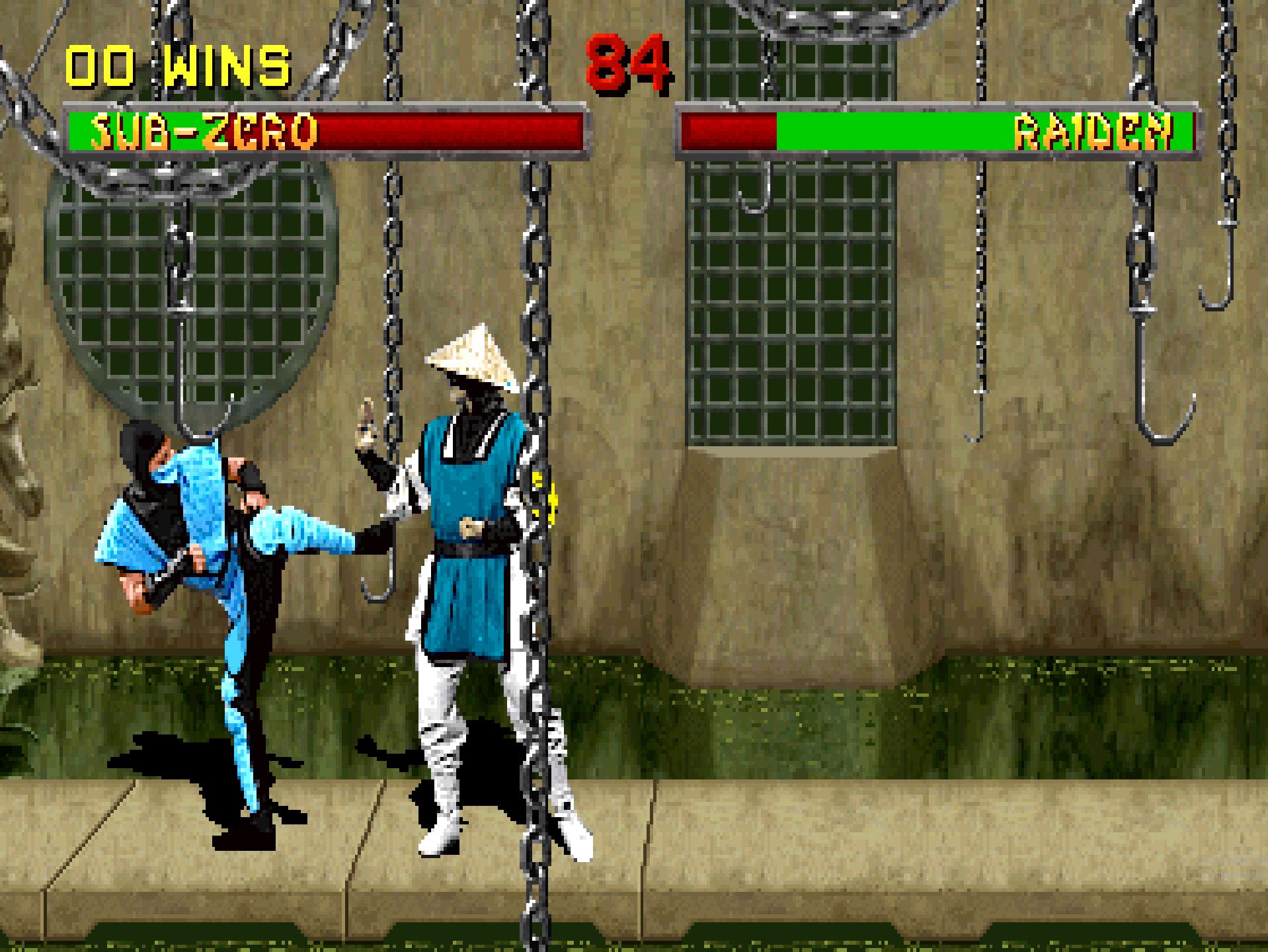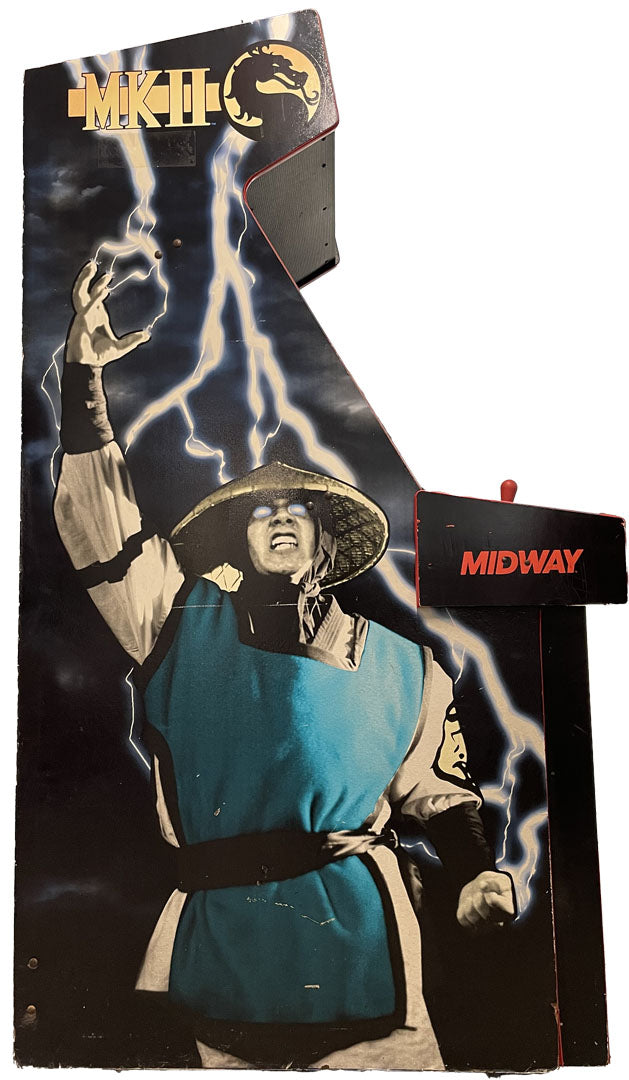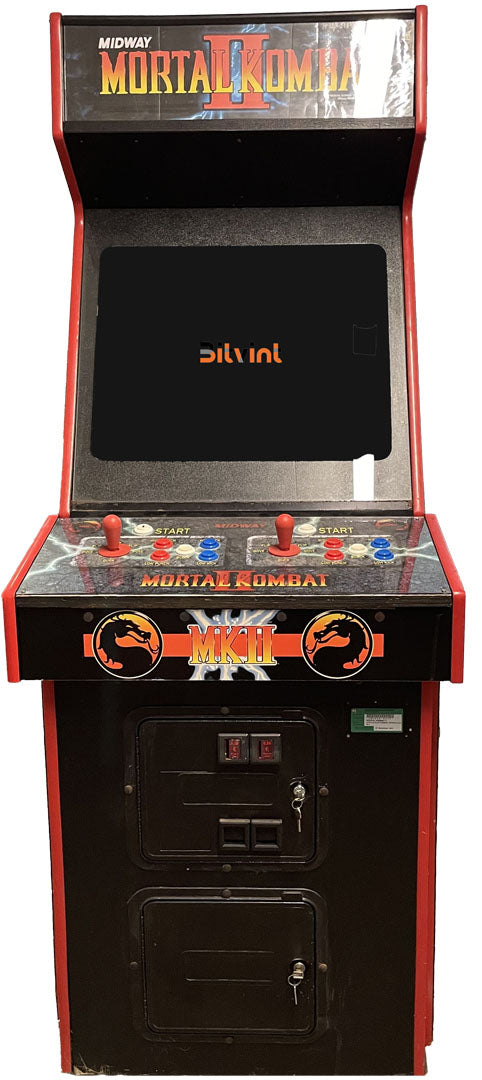Introduction
Mortal Kombat II, released in 1993 by Midway, is one of the most influential fighting games in arcade history. Known for its brutal combat, iconic characters, and the introduction of fatalities, Mortal Kombat II raised the stakes for fighting games worldwide.

History and Development
Mortal Kombat II was developed by Midway Games and was the second installment in the Mortal Kombat series. Following the massive success of the original game, Mortal Kombat II brought even more innovation to the arcade, including improved graphics, new characters, and an expanded roster of moves and finishing moves, including the now-infamous "Fatalities." The game’s success was in large part due to its competitive gameplay, gory finishing moves, and over-the-top action.
This game took the formula of its predecessor and refined it with new features that appealed to both hardcore fighting game enthusiasts and casual players alike. It became a cultural phenomenon, sparking intense competition in arcades around the world and leaving a lasting legacy on the fighting game genre.

Mortal Kombat 2 Gameplay Video
Gameplay and Objectives
In Mortal Kombat II, players engage in one-on-one combat with a variety of characters, each with unique moves, special attacks, and finishing moves. The objective is to defeat your opponent in a series of rounds, typically best of three, with each round culminating in the ability to perform a Fatality move to finish off your opponent in a gruesome and memorable way.
Key Gameplay Features:
- Combat System: Players fight in 2D side-scrolling arenas, utilizing a combination of punches, kicks, and special attacks to lower their opponent’s health bar.
- Special Moves: Each character has unique special moves that add variety to the combat. These can be performed using specific button combinations, and mastering them is key to success.
- Fatalities: The addition of Fatalities in Mortal Kombat II became one of the game’s most iconic features. These finishing moves are executed when an opponent’s health bar is fully depleted, allowing players to perform grotesque and over-the-top finishing moves that became a signature of the franchise.
- Playable Characters: The game introduced several new characters to the roster, including:
- Two-Player Mode: Players can compete head-to-head in arcade mode, while also engaging in tournament-style play against the AI or against other players for dominance.
Tip for Players: Mastering special moves and learning the timing for Fatalities is essential for success in Mortal Kombat II. Focus on controlling the pace of the fight with combos and keeping your opponent on the defensive.

Unique Features and Innovations
Mortal Kombat II was a major step forward in the evolution of fighting games, offering innovations that made the gameplay more competitive, dynamic, and engaging for players.
Key Innovations:
- Graphics and Animation: Mortal Kombat II greatly improved the graphics of its predecessor, with more detailed character animations, better visual effects, and vibrant backgrounds. This made the game more immersive and exciting to play.
- Expanded Roster: The game introduced several new characters, bringing fresh fighting styles and moves to the game, while also retaining favorites like Scorpion, Sub-Zero, and Raiden.
- Multiple Finishers: While Mortal Kombat introduced Fatalities, Mortal Kombat II expanded this concept with the addition of Friendships, Babality, and Stage Fatalities, offering more ways to defeat opponents in fun and grotesque ways.
- Improved AI: The game’s AI was smarter and more challenging, providing a greater challenge for solo players while also ensuring a fun and competitive experience for two-player matches.

Mortal Kombat 2's Fatalities: A Gory Game-Changer
"Mortal Kombat 2" (MK2) is renowned for introducing the concept of "Fatalities" to the gaming world. These finishing moves are brutal, graphic, and often humorous actions executed by victorious players, resulting in the defeat of their opponent in the most spectacular and gory fashion.
Fatalities became an integral part of the Mortal Kombat franchise's identity, contributing to the game's notoriety and controversy. Players quickly learned secret button combinations to trigger these gruesome sequences, adding a layer of strategy to the battles.
These finishing moves varied greatly among characters, ranging from Scorpion's iconic "Get over here!" spear impalement to Sub-Zero's spine-ripping "Spine Rip." Each Fatality aimed to outdo the others in terms of shock value and creativity.
MK2's Fatalities sparked national debate and even congressional hearings, ultimately leading to the establishment of the Entertainment Software Rating Board (ESRB) to regulate video game content. Despite the controversy, Fatalities remain an enduring and iconic element of the Mortal Kombat series, defining a generation of arcade gaming.
Strategies for High Scores
- Learn the Combos: Each character has a set of devastating combos that can do a lot of damage if executed correctly. Mastering these combos will give you a significant edge over your opponent.
- Use Special Moves: Each character has powerful special moves that can turn the tide of battle in your favor. Make sure to practice these to use them at the right moments.
- Finish the Fight with a Fatality: A key strategy to boosting your score and showing off your skills is performing a Fatality at the end of the match. Perfecting these moves is crucial for maximizing your experience.
Legacy and Player Reception
Mortal Kombat II is widely regarded as one of the best fighting games ever made. It built upon the foundation of the original Mortal Kombat and cemented the franchise as one of the most iconic in gaming history. The game’s success in arcades was so immense that it was eventually ported to numerous home consoles, and it inspired multiple sequels, spin-offs, and even films.
Community Feedback:
- Players Appreciate: The improved graphics, new characters, and the iconic Fatalities that made the game fun and competitive.
- Critics Note: Some players found the difficulty curve steep, but the game’s competitive nature kept players coming back for more.
Awards and Recognition: Mortal Kombat II has been consistently ranked as one of the greatest arcade games of all time. Its revolutionary impact on the fighting game genre has influenced countless games in the years since its release.

Fun Facts
- Fatality Fame: The Fatalities in Mortal Kombat II became legendary, with players constantly competing to master the most brutal finishing moves.
- New Characters: Mortal Kombat II introduced several fan-favorite characters, like Kitana, Mileena, and Baraka, which became staples in the series.
- Global Impact: The success of Mortal Kombat II helped propel the series into pop culture, with references in films, television shows, and more.

Conclusion
Mortal Kombat II remains a beloved classic in the fighting game genre, with its innovative mechanics, iconic characters, and unforgettable Fatalities. Whether you're revisiting this nostalgic hit or experiencing it for the first time, Mortal Kombat II continues to deliver an intense and exciting arcade experience that has earned its place as a true classic in the history of gaming.
Explore More
Love arcade games? Check out our guides on Street Fighter II, Donkey Kong, and Pac-Man to dive deeper into the world of competitive arcade fighting!
Questions you might have:
What are some of the iconic characters in Mortal Kombat 2?
Iconic characters in Mortal Kombat 2 include Scorpion, Sub-Zero, Raiden, Kitana, Mileena, Jax, Baraka, and Shang Tsung, among others.
How does the gameplay in Mortal Kombat 2 differ from the first game?
Mortal Kombat 2 introduced faster and more fluid gameplay, responsive controls, and new special moves. It also expanded the character roster and added stage fatalities.
What are the famous "Fatalities" in Mortal Kombat 2?
Mortal Kombat 2 featured a variety of famous Fatalities, such as Scorpion's "Toasty!" uppercut, Sub-Zero's "Spine Rip," and Liu Kang's "Dragon."
Were there any controversies or debates surrounding Mortal Kombat 2?
Yes, Mortal Kombat 2 was controversial due to its graphic violence and fatalities. It led to congressional hearings on video game violence and the creation of the Entertainment Software Rating Board (ESRB).
Can you play Mortal Kombat 2 arcade today, or is it only available as a retro game?
Mortal Kombat 2 is available as a retro game and can be played on various platforms, including emulators, gaming consoles, and arcade cabinets.
Were there any unique stages or levels in Mortal Kombat 2?
Mortal Kombat 2 featured unique and interactive stages, such as the Dead Pool with its acid pit and the Living Forest with attacking trees.
What impact did Mortal Kombat 2 have on the arcade gaming industry?
Mortal Kombat 2 had a significant impact, solidifying Midway's position in the arcade industry, inspiring a competitive scene, and sparking national debates on video game violence and regulation.
Are there any secret characters or hidden features in Mortal Kombat 2?
Mortal Kombat 2 had various secret characters and hidden features, adding to its mystique. For example, players could unlock hidden characters like Smoke and Jade through specific button combinations.

